| Accession number: | 10009 | |
| Neuron name: | LC9 |
| Synonyms: | AOT, S4, LCL7 |
| Position of cell bodies: | LCBR-LD |
| Number of cells: | 83-102? |
| Neuron class: | visual projection neuron, lobula columnar neuron |
| Innervating regions: | LO3, LO4, LO5, LO6, PVLP (GL11) [vlpr in Otsuna and Ito (2006), Fischbach and Dittrich (1989)] |
| Presynaptic sites: | LO5, LO6, PVLP (GL11) [vlpr in Otsuna and Ito (2006), Fischbach and Dittrich (1989)] |
| Postsynaptic sites: | |
| Direction of information: | centripetal |
| Laterality: | ipsilateral |
| Publications: | -
Otsuna and Ito (2006) J. Comp. Neurol. 497:928-958 |
| |
| Strains / Antibodies: | NP0681-Gal4, NP6250-Gal4, NP7067-Gal4 |
| |
| Morphological description: | Like LC6, the cell bodies of the LC9 neurons lie in the mid dorsal area of the lateral cell body region. In the lobula they are likely to arborize in the LO3, 4, 5 and 6 layers, forming two layers of densely contributed areas in LO3/4 and LO5/6. The bundle of LC9 axons run separately from that of the LC10 neurons (Figure 2). The bundle makes a round turn shortly after the AOT reaches the lateralmost area of the optu (optu3). After entering the vlpr, the LC9 axons run straight posteriorly to terminate in the central part of the dorsal posterior vlpr. The terminal area of the LC9 spreads to form a triangular shape with two apices in its lateral and medial sides (arrowheads in Figures 1 and 3).
The cell bodies of LC6, 9 and 10 form a single large cluster in the mid dorsal area of the lateral cell body region. Like all other LCs, the cell body fibers run towards the lobula neck and bifurcate there.
The n-syb::GFP signal in the lobula was observed in broader layers than LC6 (Figure 4). It is rather likely that the presynaptic sites would be distributed both in LO5 and LO6 layers. In the vlpr, presynaptic sites are confined in the posteriormost end of the bundle. Thus, LC9 is a centripetal pathway with the collateral output in the LO5 and 6 layers. It is important to note that, although LC6 and LC9 run through the anterior vlpr, they form presynapses only in the posterior area of the vlpr. It is likely that the anterior part of the vlpr does not receive visual information.
Like LC6, none of the GAL4 strains label LC9 specifically. The strain NP6563 is most specific, which labels some of the LC10 neurons only faintly. If we assume that most of the cells labeled in this strain would be associated with LC9, the cell count would be slightly less than 83-102.
(Otsuna and Ito, 2007)
|
| |
| Functional description: | |
| |
| |
| Figure 1: |  |
| 3D stereograms from three viewing angles. (Neurons other than LC9 are erased from the data. ) Yellow arrowheads indicate the edges of the triangular projection terminals in the vlpr.
CB, position of the cell bodies; neck, medial edge of the lobula where all the lobula-specific VPNs converge; vlpr, ventrolateral protocerebrum; AOT, anterior optic tract, LO3, 4, 5, 6: arborized layers in the lobula. Modified from Otsuna and Ito (2006).
|
| |
Figure 2: | 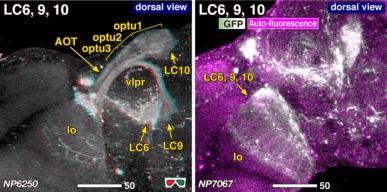 |
| Combined staining of LC6, 9 and 10, showing the spatial relationship of each pathway. optu1, 2, 3, three zones of the optic tubercle. Modified from Otsuna and Ito (2006). |
| |
Figure 3: | 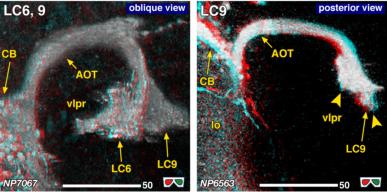 |
| Detailed arborization pattern in the vlpr. Modified from Otsuna and Ito (2006). |
| |
Figure 4: | 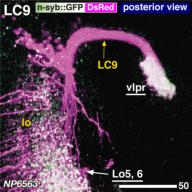 |
| Distribution of the presynaptic sites. Staining with the presynaptic site-targeted n-syb::GFP (green to white) and cytoplasmic DsRed (magenta). White characters with under bar indicate the areas of arborizations with presynaptic sites. Modified from Otsuna and Ito (2006). |
| |
File 1: | 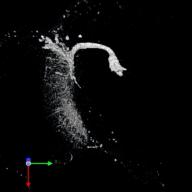 |
| QTVR movie of LC9. from Otsuna and Ito (2006). |
| |
File 2: | 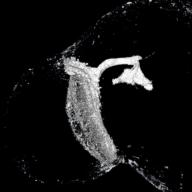 |
| QTVR movie of LC6 and 9 combined. from Otsuna and Ito (2006). |

